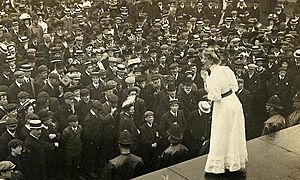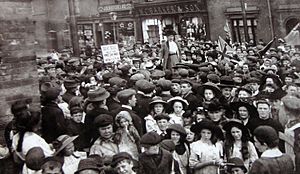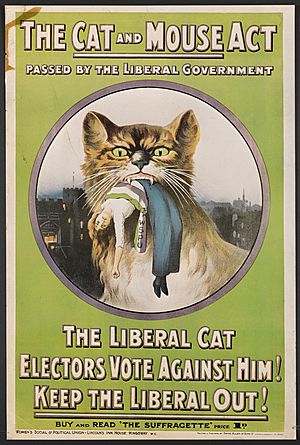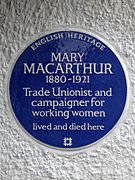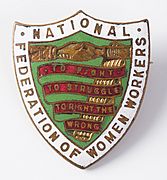Mary Macarthur facts for kids
Quick facts for kids
Mary Macarthur
|
|
|---|---|
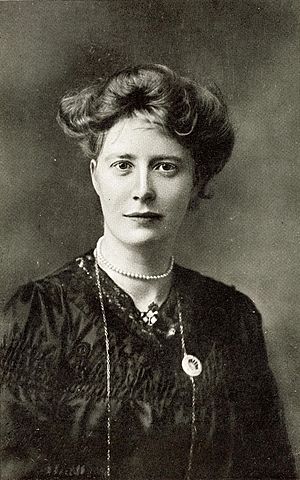 |
|
| Born |
Mary Reid Macarthur
8 December 1880 Glasgow, Scotland
|
| Died | 1 January 1921 (aged 40) Golders Green, London, England
|
| Known for | Women's trade unionism and women's suffrage |
| Spouse(s) | William Anderson |
Mary Reid Anderson (born Macarthur; 13 August 1880 – 1 January 1921) was an important Scottish leader. She fought for women's rights to vote and for better working conditions. Mary was a key figure in the trade union movement, which helps workers.
She was the main secretary of the Women's Trade Union League. She also helped create the National Federation of Women Workers and the National Anti-Sweating League. In 1910, Mary led women chain makers in Cradley Heath to win a fair minimum wage. She became a trade unionist around 1901 after learning about how badly some workers were treated.
Contents
Early Life and Family
Mary Macarthur was born in Glasgow, Scotland, on 13 August 1880. She was the oldest of six children. Her father, John Duncan Macarthur, owned a fabric shop.
Mary went to Glasgow Girls' High School. She edited the school magazine and thought about becoming a writer. After school, she studied in Germany. Later, she returned to Scotland to work as a bookkeeper for her father.
Marriage and Children
Mary became involved in politics. She met William Crawford Anderson, who was a leader in the Independent Labour Party. They married in 1911.
Their first child was born in 1913 but sadly died. Their daughter, Anne Elizabeth, was born in 1915. William died four years later in the 1919 flu outbreak. Mary herself passed away from cancer on 1 January 1921, at just 40 years old. She died in Golders Green, London.
Fighting for Workers' Rights
In 1903, Mary moved to London. There, she became the Secretary of the Women's Trade Union League. This group brought together unions for women from different jobs.
Mary strongly believed that all adults should have the right to vote. She disagreed with groups like the NUWSS and the WSPU. These groups were willing to let only some women vote at first. Mary worried that this would hurt working-class women. She feared it would make it harder to get full voting rights for everyone.
Creating the National Federation of Women Workers
To help more women, Mary started the National Federation of Women Workers in 1906. This group was a general union for women. It was open to all women in jobs that didn't have unions. It also helped women who were not allowed into other unions. This federation was led by and for women.
Mary also worked to stop "sweating" in industries. This meant workers, often women, were paid very little for long hours. In 1905, she helped with an exhibition about these "sweated industries." In 1906, she helped form Britain's National Anti-Sweating League.
The next year, she started Women Worker. This was a monthly newspaper for women in trade unions. In 1908, she shared her research on poor working women with the government. Her efforts helped lead to the Trade Boards Act 1909. This law set a minimum wage for some workers.
The Cradley Heath Chainmakers' Strike
In 1910, Mary led a famous strike. The women chainmakers of Cradley Heath were paid very little, barely enough to live. Mary helped them fight for fair wages. The strike lasted 10 weeks.
On 22 October 1910, the employers finally agreed to pay the minimum wage. This was a huge victory. It changed the lives of thousands of workers. Mary once said, "women are unorganised because they are badly paid, and poorly paid because they are unorganised." This showed how important unions were for women.
The Bermondsey Uprising
Mary's fame from Cradley Heath led her to help with another big strike. In August 1911, 14,000 women suddenly went on strike in Bermondsey. They worked in food and drink factories. The conditions were terrible, especially in the summer heat.
Mary quickly organized the strikers. She led talks with the factory owners. She helped these low-paid women win a historic victory. A large rally was held in Southwark Park. Mary gave a powerful speech, supported by other women's rights activists.
Women's Vote and War Efforts
In 1913, the government passed the Prisoners (Temporary Discharge for Ill Health) Act 1913. This law was nicknamed the "Cat and Mouse Act." It allowed hunger-striking women's rights prisoners to be released when they were very weak. But they could be arrested again once they got better.
Mary was part of a group that met with the Home Secretary to discuss this act. When the women refused to leave the House of Commons, Mary and another activist were physically removed.
Mary believed in voting rights for all, not just women. She made sure her fight for votes didn't get mixed up with her campaigns for better pay. She knew she needed the support of male union members and politicians. After World War I, women over 30 were allowed to vote and stand for Parliament. Mary saw this as her next challenge.
Even though she was against the war, Mary became secretary of a government committee. This committee focused on women's employment during the war.
Standing for Parliament
In 1918, a new law allowed women to vote and run for Parliament. Mary stood as a candidate for the Labour Party in Stourbridge. The election was on 14 December 1919.
The election official insisted she be listed by her married name, Mrs. W.C. Anderson. She faced tough opponents. Mary lost the election, as did many candidates who were against the war, including her husband.
Mary continued her work with the Women's Trade Union League. She played a big part in turning it into the Women's section of the Trade Union Congress. Mary Macarthur died on 1 January 1921.
Mary Macarthur's Legacy
Mary Macarthur's work continues to be remembered.
- An exhibition about her is at the Black Country Living Museum. It is in the rebuilt Cradley Heath Workers' Institute.
- The Mary Macarthur Scholarship Fund (1922) and Educational Trust (1968) were set up. They help working women get better education.
- The Mary Macarthur Holiday Trust helps provide holidays for women in need.
- A statue of Mary Macarthur was put up in Cradley Heath in 2012. A street there is also named after her.
- In 2017, a blue plaque was placed on her home in Golders Green. This marks where she lived during her most active years.
- Her name is on the base of the statue of Millicent Fawcett in Parliament Square, London. This statue honors women who fought for the right to vote.
- Some social housing in London is named after Mary Macarthur.
Gallery
-
Blue plaque erected at 42 Woodstock Road, Golders Green, March 7th 2017
See also
 In Spanish: Mary Macarthur para niños
In Spanish: Mary Macarthur para niños


